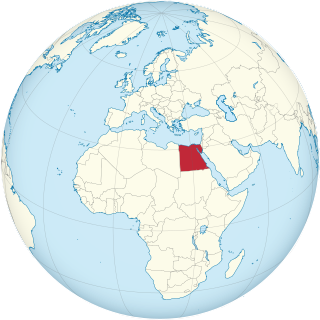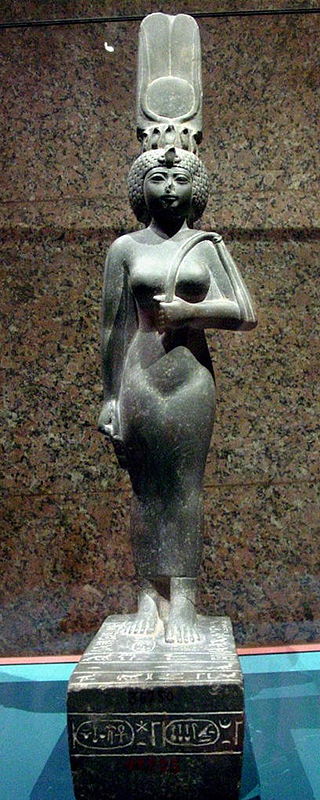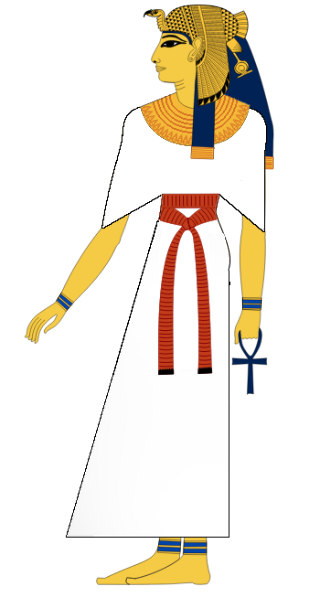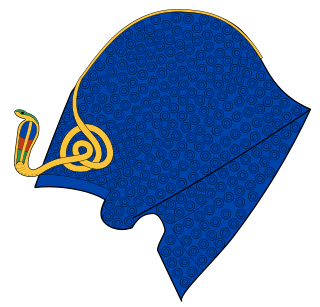Thutmose (also rendered Thutmoses, Thutmosis, Tuthmose, Tutmosis, Thothmes, Tuthmosis, Thutmes, Dhutmose, Djhutmose, Djehutymes, etc.) is an anglicization of the ancient Egyptian personal name dhwty-ms, usually translated as "Born of the god Thoth".
Thoutmôsis (in Ancient Greek Θούθμωσις / Thoúthmôsis) is the Hellenized form of the Egyptian Ḏḥwtj-mś (reconstructed pronunciation: /tʼaˈħawtij ˈmissaw/) and means "Born of Thoth". This theophoric name was part of the royal titulary of four pharaohs of the 18th dynasty as the name of Sa-Rê or "birth name". It was also worn by the eldest son of Amenhotep III, high priest of Ptah, as well as by a vizier who exercised his functions successively under Thutmose IV and Amenhotep III. Under this last king and under his successor, Amenhotep IV, two other high dignitaries, royal sons of Kush, similarly called themselves "Born[s] of Thoth".

Akhenaten, also spelled Akhenaton or Echnaton, was an ancient Egyptian pharaoh reigning c. 1353–1336 or 1351–1334 BC, the tenth ruler of the Eighteenth Dynasty. Before the fifth year of his reign, he was known as Amenhotep IV.
Amenhotep is an ancient Egyptian name. Its Greek version is Amenophis (Ἀμένωφις). Its notable bearers were:

Thutmose III, sometimes called Thutmose the Great, was the sixth pharaoh of the 18th Dynasty. Officially he ruled Egypt from 28 April 1479 BC until 11 March 1425 BC, commencing with his coronation at the age of two and concluding with his death, aged fifty-six; however, during the first 22 years of his reign, he was coregent with his stepmother and aunt, Hatshepsut, who was named the pharaoh. While he was depicted as the first on surviving monuments, both were assigned the usual royal names and insignia and neither is given any obvious seniority over the other. Thutmose served as commander of Hatshepsut's armies. During the final two years of his reign after the death of his firstborn son and heir Amenemhat, he appointed his son and successor Amenhotep II as junior co-regent.

Articles related to Egypt include:

Amenhotep III, also known as Amenhotep the Magnificent or Amenhotep the Great and Hellenized as Amenophis III, was the ninth pharaoh of the Eighteenth Dynasty. According to different authors following the "Low Chronology", he ruled Egypt from June 1386 to 1349 BC, or from June 1388 BC to December 1351 BC/1350 BC, after his father Thutmose IV died. Amenhotep was Thutmose's son by a minor wife, Mutemwiya.

Thutmose I was the third pharaoh of the 18th Dynasty of Egypt. He received the throne after the death of the previous king, Amenhotep I. During his reign, he campaigned deep into the Levant and Nubia, pushing the borders of Egypt farther than ever before in each region. He also built many temples in Egypt, and a tomb for himself in the Valley of the Kings; he is the first king confirmed to have done this.

Thutmose II was the fourth Pharaoh of the Eighteenth Dynasty of Egypt, and his reign is generally dated from 1493 to 1479 BC. Little is known about him and he is overshadowed by his father Thutmose I, half-sister and wife Hatshepsut, and son Thutmose III. He died around the age of 30 and his body was found in the Deir el-Bahri Cache above the Mortuary Temple of Hatshepsut.

Amenhotep II was the seventh pharaoh of the Eighteenth Dynasty of Egypt. He inherited a vast kingdom from his father Thutmose III, and held it by means of a few military campaigns in Syria; however, he fought much less than his father, and his reign saw the effective cessation of hostilities between Egypt and Mitanni, the major kingdoms vying for power in Syria. His reign is usually dated from 1427 to 1401 BC. His consort was Tiaa, who was barred from any prestige until Amenhotep's son, Thutmose IV, came into power.

Thutmose IV was the 8th Pharaoh of the 18th Dynasty of Egypt, who ruled in approximately the 14th century BC. His prenomen or royal name, Menkheperure, means "Established in forms is Re." He was the son of Amenhotep II and Tiaa. Thutmose IV was the grandfather of Akhenaten.

The New Kingdom, also called the Egyptian Empire, refers to ancient Egypt between the 16th century BC and the 11th century BC. This period of ancient Egyptian history covers the Eighteenth, Nineteenth, and Twentieth dynasties. Through radiocarbon dating, the establishment of the New Kingdom has been placed between 1570 BC and 1544 BC. The New Kingdom followed the Second Intermediate Period and was succeeded by the Third Intermediate Period. It was the most prosperous time for the Egyptian people and marked the peak of Egypt's power.

Atenism, also known as the Aten religion, the Amarna religion, and the Amarna heresy, was a religion in ancient Egypt. It was founded by Akhenaten, a pharaoh who ruled the New Kingdom under the Eighteenth Dynasty. The religion is described as monotheistic or monolatristic, although some Egyptologists argue that it was actually henotheistic. Atenism was centered on the cult of Aten, a god depicted as the disc of the Sun. Aten was originally an aspect of Ra, Egypt's traditional solar deity, though he was later asserted by Akhenaten as being the superior of all deities.
The former Kingdom of Kerma in Nubia, was a province of ancient Egypt from the 16th century BCE to 11th century BCE. During this period, the region was ruled by a viceroy who reported directly to the Egyptian Pharaoh.

God's Wife of Amun was the highest-ranking priestess of the Amun cult, an important religious institution in ancient Egypt. The cult was centered in Thebes in Upper Egypt during the Twenty-fifth and Twenty-sixth dynasties. The office had political importance as well as religious, since the two were closely related in ancient Egypt.

Great Royal Wife, or alternatively, Chief King's Wife is the title that was used to refer to the principal wife of the pharaoh of Ancient Egypt, who served many official functions.

The khepresh (ḫprš) was an ancient Egyptian royal headdress. It is also known as the blue crown or war crown. New Kingdom pharaohs are often depicted wearing it in battle, but it was also frequently worn in ceremonies. While it was once called the war crown by many, modern historians refrain from characterizing it thus.
Amenemope, also Amenemopet, Amenemipet or Amunemopet(ỉmn-m-ỉp3.t, Greek: αμενωφις; “Amun in Luxor”) is an Ancient Egyptian name. Its notable bearers were:

The High Priest of Amun or First Prophet of Amun was the highest-ranking priest in the priesthood of the ancient Egyptian god Amun. The first high priests of Amun appear in the New Kingdom of Egypt, at the beginning of the Eighteenth Dynasty.

The Temple of Amada, is one of the oldest Egyptian Temples in Nubia. It was constructed during the 18th Dynasty by Pharaoh Thutmose III. It is one of the oldest Egyptian buildings still present along Lake Nasser. In total, three generations contributed to building the temple. Minor modifications continued into the 19th Dynsaty. The temple was dedicated to Amun-Ra and Horakhty-Ra.

The Eighteenth Dynasty of Egypt is classified as the first dynasty of the New Kingdom of Egypt, the era in which ancient Egypt achieved the peak of its power. The Eighteenth Dynasty spanned the period from 1550/1549 to 1292 BC. This dynasty is also known as the Thutmoside Dynasty) for the four pharaohs named Thutmose.
This page list topics related to ancient Egypt.














